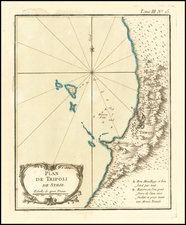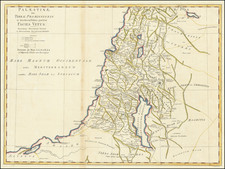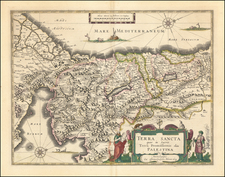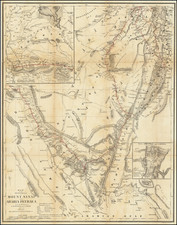Detailed map of the lands of the Tribe of Naphtali in the Holy Land, from Christian van Adrichom's Theatrum Terrae Sanctae, first publshed in 1590.
Following the completion of the conquest of Canaan by the Israelite tribes after about 1200 BCE, Joshua allocated the land among the twelve tribes. The Tribe of Naphtali was allocated the eastern side of the Galilee (on the immediate west of the Sea of Galilee), in the areas now known as the Lower Galilee, and Upper Galilee, and was bordered on the west by Asher, in the north by Dan, in the south by Zebulun, and by the Jordan River in the east. (Joshua 19:32-39) The most significant city was Hazor.
In this region, bordering the Sea of Galilee, was the highly fertile plain of Gennesaret, characterized by Josephus as the ambition of nature, an earthly paradise, and with the southern portion of the region acting as a natural pass between the highlands of Canaan, several major roads (such as those from Damascus to Tyre and Acre) ran through it. The prosperity this situation brought is seemingly prophesied in the Blessing of Moses, though textual scholars view this as a postdiction, dating the poem to well after the tribe had been established in the land.
The Theatrum Terrae Sanctae was an atlas and history of the Holy Land and was Adrichom's most important and famous work. Born in Delft, Christian Kruik van Adrichem, or Christianus Crucius Adrichomius, was a priest and theologian. Adrichom worked for thirty years on his three-part history of the Holy Land, but only published the first part, Urbis Hierosolyma Depicta, during his lifetime. The remaining two parts were published posthumously by Georg Braun in 1590, with subsequent editions in 1593, 1600, 1613, 1628, and 1682.
The Theatrum Terrae Sanctae contained 12 maps and plans: one of the Holy Land, nine of territories of the Tribes of Israel, one of the Exodus, and a town plan of Jerusalem.









![[ Maccabee Tomb ] Grafgebouw Der Makkabeen Opgeregt Te Modin](https://storage.googleapis.com/raremaps/img/small/101602.jpg)



![(Israel) Tabula Moderna Terre Sancte [Modern Map of the Holy Land]](https://storage.googleapis.com/raremaps/img/small/101884.jpg)
